Greyhawk, also known as the World of Greyhawk, is a fictional world designed as a campaign setting for the Dungeons & Dragons fantasy roleplaying game. Although not the first campaign world developed for Dungeons & Dragons—Dave Arneson's Blackmoor campaign predated it by over a year—the world of Greyhawk closely identified with early development of the game beginning in 1972, and after being published it remained associated with Dungeons & Dragons publications until 2008. The world itself started as a simple dungeon under a castle designed by Gary Gygax for the amusement of his children and friends, but it was rapidly expanded to include not only a complex multi-layered dungeon environment, but also the nearby city of Greyhawk, and eventually an entire world. In addition to the campaign world, which was published in several editions over twenty years, Greyhawk was also used as the setting for many adventures published in support of the game, as well as for RPGA's massively shared Living Greyhawk campaign from 2000–2008.
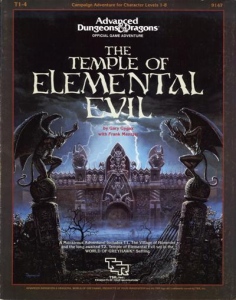
The Temple of Elemental Evil is an adventure module for the fantasy role-playing game Dungeons & Dragons, set in the game's World of Greyhawk campaign setting. The module was published by TSR, Inc. in 1985 for the first edition Advanced Dungeons & Dragons rules. It was written by Gary Gygax and Frank Mentzer, and is an expansion of an earlier Gygax module, The Village of Hommlet. The Temple of Elemental Evil is also the title of a related 2001 Thomas M. Reid novel and an Atari computer game.

Scourge of the Slave Lords (A1–4) is an adventure module for the Dungeons & Dragons fantasy role-playing game, published by TSR, Inc. in 1986. It combines the contents of four earlier modules, all set in the World of Greyhawk campaign setting and intended for use with Advanced Dungeons & Dragons first edition rules.

Descent Into the Depths of the Earth is an adventure module for the Dungeons & Dragons (D&D) fantasy roleplaying game coded D1–2. It was written by Gary Gygax, and combines two previously published modules from 1978, the original Descent into the Depths of the Earth and Shrine of the Kuo-Toa. A sequel to the first two modules, Vault of the Drow, was also published in 1978. All of these D-series modules were produced for use with the 1st edition Advanced Dungeons & Dragons (AD&D) rules.
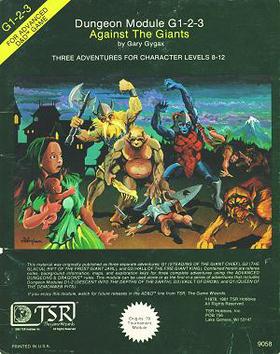
Against the Giants is an adventure module written by Gary Gygax and published by TSR in 1981 for the Dungeons & Dragons fantasy role-playing game. It combines the G series of modules previously published in 1978: Steading of the Hill Giant Chief, Glacial Rift of the Frost Giant Jarl, and Hall of the Fire Giant King. All three were produced for use with the 1st edition Advanced Dungeons & Dragons rules. In 1999, to recognize the 25th anniversary of TSR, the company released an updated version, Against the Giants: The Liberation of Geoff. Later in 1999, Wizards of the Coast published a novelization of Against the Giants by Ru Emerson.
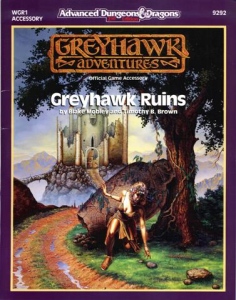
Castle Greyhawk is one of the central dungeon settings in the fictional World of Greyhawk campaign setting for the Dungeons & Dragons roleplaying game. The Castle was originally developed by Gary Gygax, for his own campaign and later detailed for publication. Castle Greyhawk is also the name of a 1988 Dungeons & Dragons adventure module that created a treatment of the Castle for the public to use. In 2005, Gygax announced the release of "Castle Zagyg," his new treatment of the dungeon.
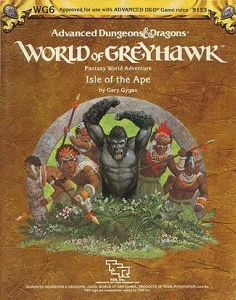
Isle of the Ape is an adventure module for the Dungeons & Dragons role-playing game World of Greyhawk campaign setting, in which the events occur in a magical demiplane of the same name created by the mad archmage Zagyg Yragerne.

Mordenkainen's Fantastic Adventure by Robert J. Kuntz and Gary Gygax is an adventure module for the Dungeons & Dragons role-playing game, published by TSR, Inc. in 1984. It originally bore the code "WG5" and was intended for use with the Advanced Dungeons & Dragons first edition rules. Because it is one of the WG modules, it is a module intended for the World of Greyhawk campaign setting. It was later updated in 2004 to the Third Edition Revised rules in Dungeon magazine, issue #112, as Maure Castle. There were subsequently two additional installments in issues #124 and #139.
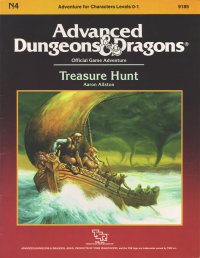
Treasure Hunt is an adventure module for the Advanced Dungeons & Dragons (AD&D) role-playing game, written by Aaron Allston for the 1st edition Advanced Dungeons & Dragons (AD&D) rules. The player characters must evolve into their roles as the adventure progresses, beginning as slaves on a galley who become freed after a shipwreck on an island where orcs and goblins contend over a treasure. The adventure received a positive review from White Dwarf magazine.
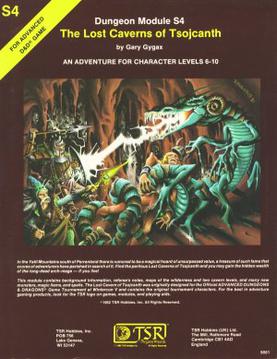
The Lost Caverns of Tsojcanth is an adventure module for the Dungeons & Dragons fantasy role-playing game. It was written by Gary Gygax and published by TSR in 1982 for the first edition Advanced Dungeons & Dragons (AD&D) rules. The 64-page adventure bears the code "S4" and is set in the Greyhawk campaign setting. It is divided into two parts, a 32-page adventure, and a 32-page booklet of monsters and magic items. The plot involves the player characters investigating rumors of lost treasure. After traversing a wilderness and two levels of dungeons, the players face Drelnza, the vampiric daughter of long-deceased archmage Iggwilv.
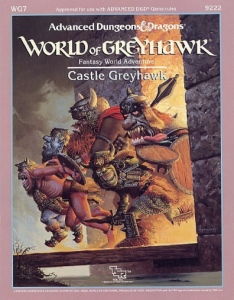
Castle Greyhawk is a comedic adventure module for the Dungeons & Dragons fantasy roleplaying game set in the World of Greyhawk campaign setting. The module bears the code WG7 and was published by TSR, Inc. in 1988 for the first edition Advanced Dungeons & Dragons rules.
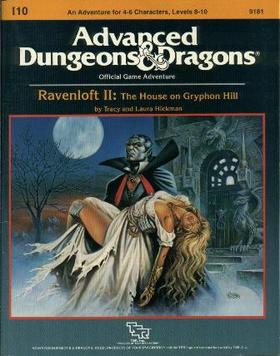
Ravenloft II: The House on Gryphon Hill is a Dungeons & Dragons module written for use with the First Edition Advanced Dungeons & Dragons ruleset, by TSR.
The DL series is a series of adventures and some supplementary material for the Advanced Dungeons & Dragons role playing game. These modules along with the Dragonlance Chronicles trilogy of novels, which follow one possible adventure series through the modules, were the first published items that established the Dragonlance fictional universe. The original DL series was released from 1984 to 1986, with the final two modules added to it in 1988. In the 1990s these roleplaying adventures from the original series were collected and revised for 2nd Edition AD&D as the three DLC Dragonlance Classics modules. There were also versions of the module series released in 1999, 2000 and 2006.

Dragons of Despair is the first in a series of 16 Dragonlance adventures published by TSR, Inc. (TSR) between 1984 and 1988. It is the start of the first major story arc in the Dragonlance series of Dungeons & Dragons (D&D) role-playing game modules, a series of ready-to-play adventures for use by Dungeon Masters in the game. This series provides a game version of the original Dragonlance storyline later told in the Dragonlance Chronicles trilogy of novels. This module corresponds to the events told in the first half of the novel Dragons of Autumn Twilight by Margaret Weis and Tracy Hickman. Its module code is DL1, which is used to designate it as the first part of the Dragonlance adventure series.
The World of Greyhawk Fantasy Game Setting and the World of Greyhawk Fantasy World Setting are two closely related publications from TSR, Inc. that detail the fictional World of Greyhawk campaign setting for the Dungeons & Dragons (D&D) fantasy roleplaying game. Both publications were authored by Gary Gygax, and they were the first stand-alone offerings to provide detailed, comprehensive information regarding a D&D campaign setting.
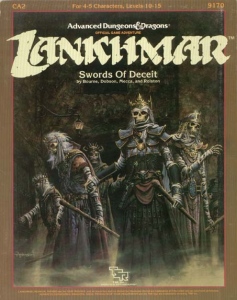
Swords of Deceit is a 1986 adventure module for the Advanced Dungeons & Dragons fantasy role-playing game, for the Lankhmar setting.

Rahasia is an adventure module, self-published by DayStar West Media in 1980 and published by TSR, Inc. in 1983 and 1984, for the Basic Set rules of the Dungeons & Dragons fantasy role-playing game. Its product designation is TSR 9115. It was designed by Tracy and Laura Hickman, and features artwork by Jeff Easley and Timothy Truman.
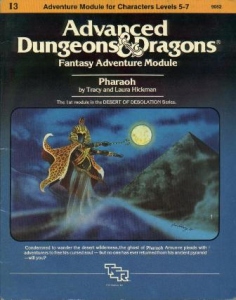
Pharaoh is an adventure module for the Dungeons & Dragons fantasy role-playing game. The module was published in 1982 by TSR, Inc. for the first edition Advanced Dungeons & Dragons rules. It formed the first of the three-part Desert of Desolation module series. The module was written by Tracy and Laura Hickman; Tracy Hickman would later go on to help create the Dragonlance campaign setting.

Desert of Desolation is a compilation adventure module published by TSR for the Dungeons & Dragons (D&D) fantasy roleplaying game. It combines three previously published individual modules: Pharaoh, Oasis of the White Palm, and Lost Tomb of Martek. The modules were made for use with the first edition Advanced Dungeons & Dragons (AD&D) rules. Pharaoh was created by Tracy and Laura Hickman soon after the couple married in 1977, and published by TSR in 1982. Oasis of the White Palm was a collaboration between Tracy Hickman and Philip Meyers, and Hickman wrote the Lost Tomb of Martek on his own; both were printed in 1983.

Red Arrow, Black Shield is an adventure module for the Dungeons & Dragons fantasy role-playing game. It was published by TSR in 1985, and designed by Michael S. Dobson. Its cover art is by Jeff Easley, and cartography by Dennis Kauth. The module's associated code is X10 and its TSR product code is TSR 9160. This module was developed and intended for use with the Dungeons & DragonsExpert Set and Companion Set rules.
















